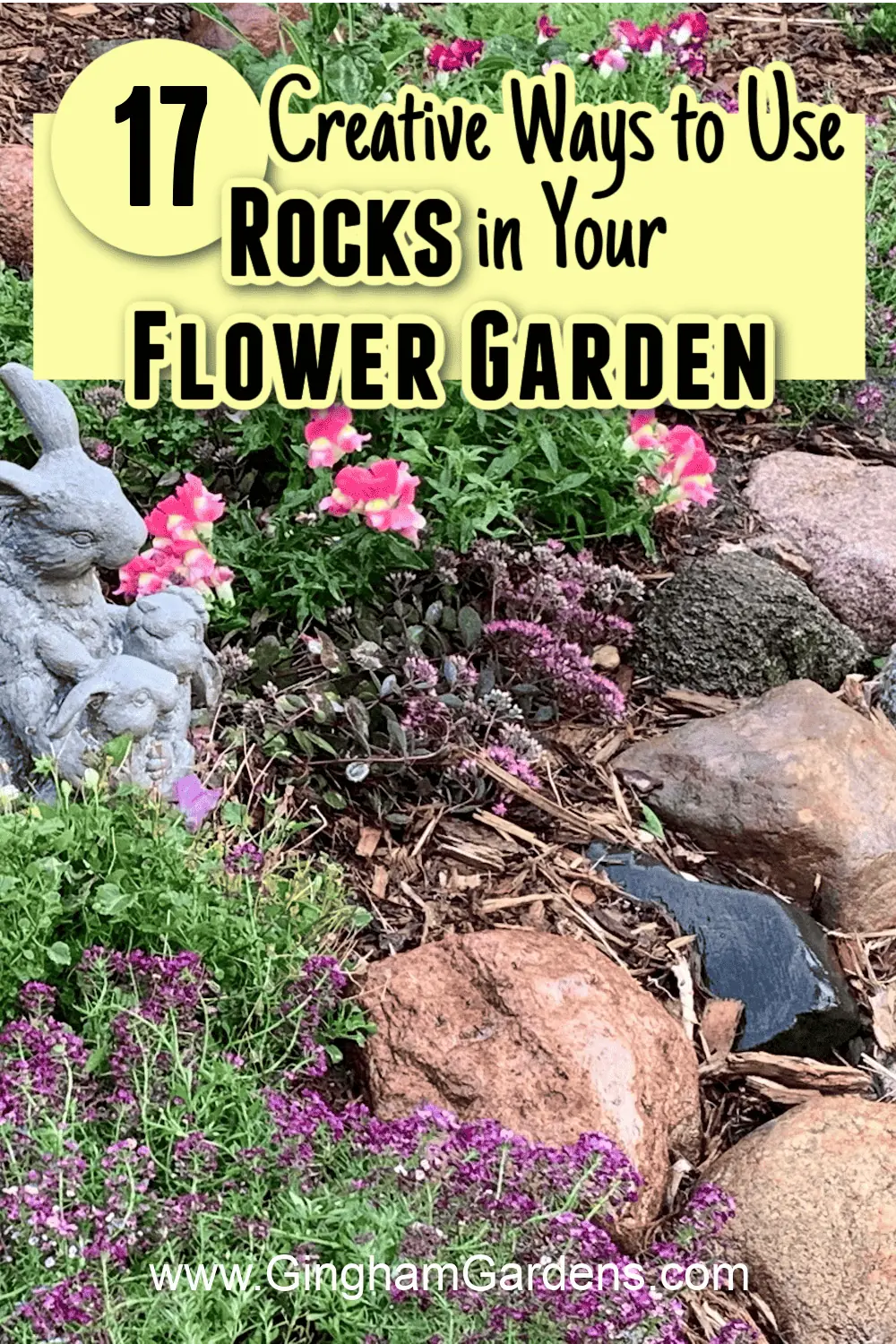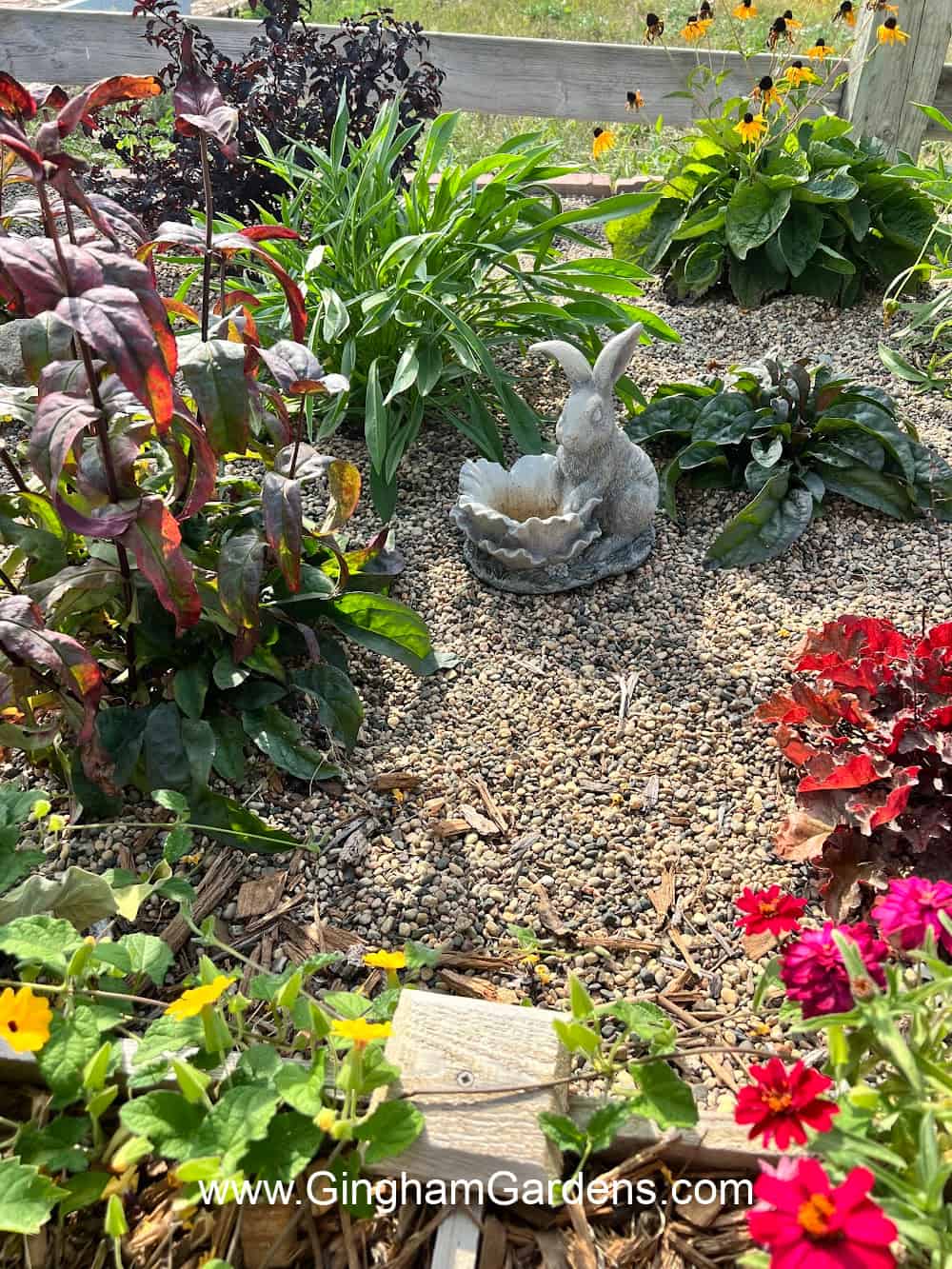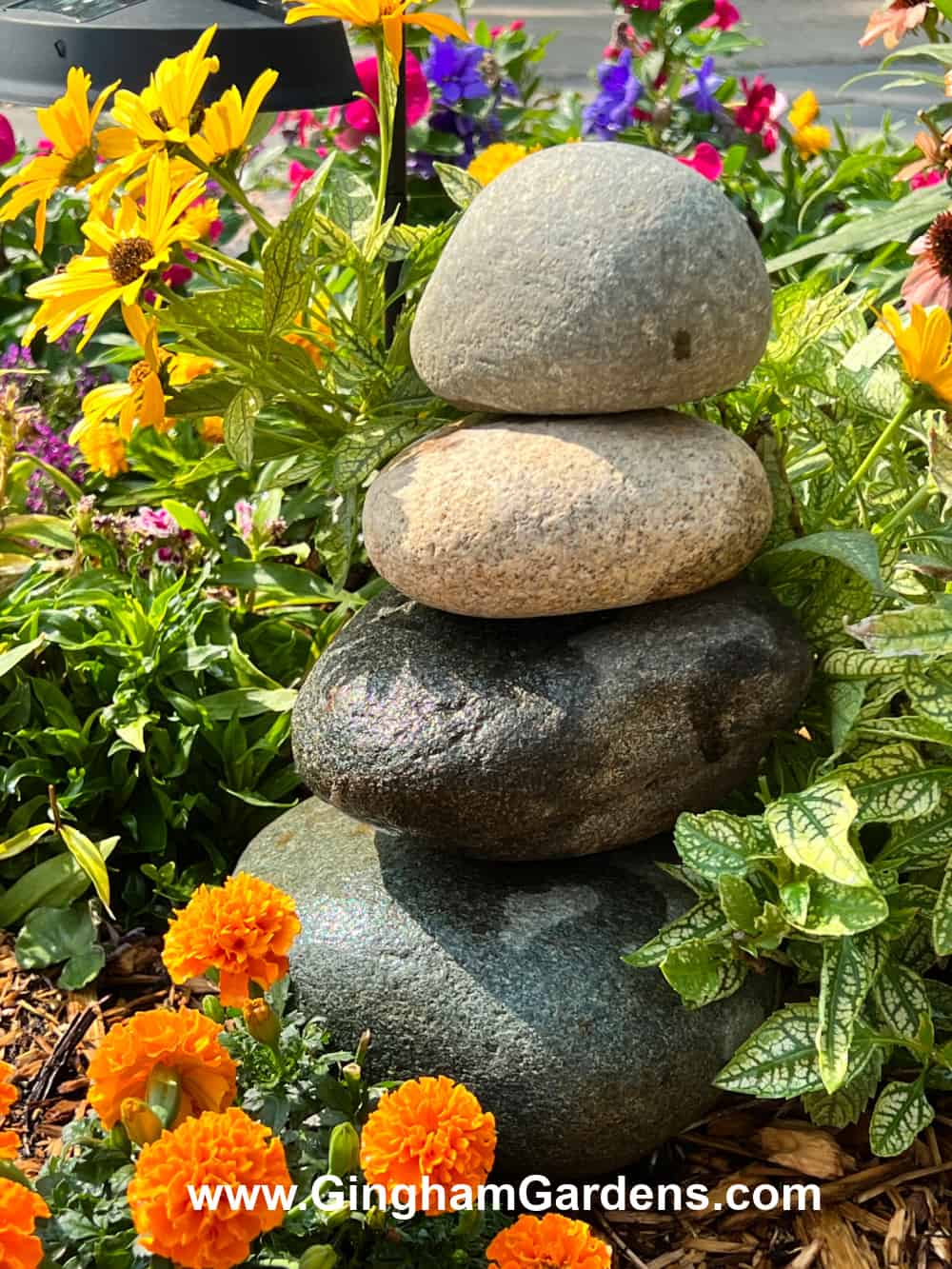Using Rocks in Your Flower Garden: Tips and Ideas
Using rocks in a flower garden can bring a unique and natural element to the overall design of your flower bed. Rocks can add texture, depth, and contrast to the vibrant colors of flowers and foliage. They can also serve as a practical solution for creating paths, retaining walls, or edging. Rocks can also fill in open spaces and create a focal point in the landscape.
Rocks and flowers just go together and incorporating rocks into your flower garden is a great way to add both aesthetic and practical benefits.
For the purposes of this article, we are using examples that most home gardeners can do themselves and not formal or professional landscaped or hardscaped areas. There are also some fun DIY projects with rocks that you can do with children, as a garden club activity, or something to do on a rainy day.
This post contains affiliate links. If you click on
one of the links and make a purchase,
I may receive a small commission at no additional cost to you.
See full disclosure here.
As a child, when vacationing, my dad was always looking for unique rocks to add to his collection. Although I didn’t think much of it then, I do now and I do the same thing.
I was even stopped by airport security once when trying to bring home rocks from Colorado. They informed me that it went against state law to remove rocks from their parks. Fortunately, in this case, I had purchased the rocks and had a receipt to prove it.
Different Types of Rocks to Use in Landscaping Projects and Gardens
When doing a little research for this article, I found some interesting information that I didn’t know. So here’s a fun little science lesson. There are three primary types of rocks: igneous, sedimentary, and metamorphic.
Igneous rocks are rocks formed from the cooling and solidification of magma or lava. They are typically hard, dense, and durable, making them ideal for use in garden paths and borders. Examples of igneous rocks include granite, basalt, and pumice.
Sedimentary rocks are rocks that are formed from the accumulation and compression of sediment over time. They are usually softer and more porous than igneous rocks, making them ideal for use in garden beds and as decorative accents. Examples of sedimentary rock include sandstone, shale, and limestone.
Metamorphic rocks are rocks formed from the transformation of existing rocks through heat and pressure. They are typically hard and dense, making them ideal for use in garden paths and retaining walls. Examples of metamorphic rocks include marble, slate, and quartzite.
Fieldstones are a type of natural stone and can be made up of all three of these rocks, depending on the area where they were formed. Fieldstones are readily available in my area and are mainly what I use for borders around my gardens. The type of rock you use will depend on natural rocks that are available in your area.
Choosing the Right Rocks for Your Garden
Color Coordination
When choosing rocks for your garden, think about the different colors. Think about selecting rocks that compliment the colors of your flowers and foliage and do not detract from them. A few good examples include:
- If you have a lot of greenery in your garden, you may want to choose rocks with warm tones like red or orange to add some contrast.
- On the other hand, if you have a lot of bright flowers, you may want to choose more neutral-colored rocks like gray or beige.
Size and Shape
The size and shape of your rocks can also have a big impact on the overall look of your garden. Here are a few things to keep in mind:
- Small gardens will look better if you choose small rocks to avoid overwhelming the space.
- If you have a lot of curves in your garden, you may want to choose rocks with a more rounded shape to complement the natural flow of your space.
- Rocks with a more angular shape are perfect for a more modern garden, like a Japanese garden or a zen garden.
- Flat stones work well for a stepping stone path or to construct a rock wall.
Save this pin (or any pictures in this article) to Pinterest so you can remember it later:
Texture
Finally, the texture of your rocks can add some visual interest to your garden. Smooth rocks can add a calming element, while rougher rocks can add some texture and contrast.
You may also want to consider the texture of your rocks in relation to your other garden elements. For example, if you have a lot of soft foliage, you may want to choose rougher rocks to create some balance.
Overall, choosing the right rocks for your garden can be a fun and creative process, but don’t get too hung up on it. Just like with plants, in most cases, rocks can be moved around.
Incorporating Rocks into Your Flower Beds
Creating Rock Borders
Adding rock borders is one of the best ways to use rocks in your flower garden. Stone borders can add a touch of creativity and help define the space.
To create a rock border, start by digging a trench around the perimeter of your garden bed. Then, place your rocks in the trench, making sure they are stable.
You can use a variety of rock sizes and shapes to create a natural-looking border. To keep weeds from growing between the rocks, I use a pre-emergent product.
Using Rocks on a Slope
In much the same way as creating a flower garden border with rocks, rocks can be used on a slope to help with erosion problems.
Creating a Rock Path Through Your Flower Garden
Rock pathways can add both a functional and beautiful element to your flower garden. To build a rock pathway, start by outlining the path with a garden hose or spray paint. Then, remove the grass or soil from the path and level the ground. Next, add landscape fabric to the path. Finally, cover the fabric with a layer of crushed stone or pea gravel and level it out.
Flagstones or other flat rocks can be placed on top of the smaller rocks, just be sure they are level and don’t create a trip hazard.
In the image below, we used field stones to edge the borders of the garden beds and used pea gravel for the path.
Using Rocks as Mulch
Although I don’t recommend using rocks as mulch in your flower garden, they are often used in landscape areas. For example; river rock and other varieties of large gravel are very popular with landscapers and are often used around home foundations.
It’s fine in that case, but if you ever have to move or remove plants, it can be a nightmare to deal with. It can look pretty for a few years, but then organic matter settles and weeds start growing, etc. Plus, it can inhibit plants from growing healthy and looking their best.
Gravel gardens, on the other hand, can be beautiful and very functional.
More Ideas for Using Rocks in Your Flower Garden
Sometimes we have to deal with large boulders that can’t be moved. We have some large granite boulders that were in our gardens when we purchased our home. Although I’m not completely happy with their placement in the gardens, I have learned to work around them. The granite boulders make a beautiful backdrop for colorful flowers.
Our neighbor also has a granite boulder in her entry garden.
Practically speaking, rocks are a great way to fill empty spaces in a flower bed. Plus, they can add lots of charm to your garden.
Rocks can be used to create small retaining walls in gardens too. Donna, a reader from Wisconsin, shares this picture of her shade garden. Notice how the stones just fit right in as a natural part of the garden.
I created this rockery in our small entry garden. As the flowers grow and fill in, it looks like they are growing out of the rocks.
DIY Projects for Your Garden Using Rocks
Decorative rocks are a great choice for adding character to your flower garden. Below are some easy ways and projects in which you can incorporate rocks into your landscape.
DIY Water Feature Using Rocks
At our former home, we constructed a small pond. When we started thinking about selling our home, we deconstructed the pond and made a simple water feature using rocks. I’m sorry I don’t have pictures showing the steps of the project, but I can tell you how we did it.
- First, use a large plastic tote and buried it, leaving the top lip of it above the soil line.
- Second, place a water pump in the bottom of the plastic tote and ran the plastic water tubing to the top of the tote.
- Third, fill the tote with water and test the pump.
- Fourth, fashion a screen to fit over the top of the tote. We used stiff hardware cloth. You will need to cut holes for the water tube and the power cord. Depending on the fountain you use for the water feature, you can also use the lid for the tote and cut the holes needed for the water feature to function. There are definitely different ways to accomplish this, so just play around with it until you find a way that works.
Once you have your water feature working properly, you can finish it by placing a mound of large river rocks to hide the top of the feature. We ended up using a variety of smaller and larger rocks that we had on hand. This really is a fairly easy way to create a unique water feature in your garden.
Stacked Rock Sculpture
Stone stacking or rock balancing is an entire art in and of itself. It takes a bit of patience and playing around to get the right combination. Once you get it just right, snap a picture in case you can’t remember the order of your stones. I decided not to use large stones because I have a hard time leaving garden art in one place.
Now start all over again and add glue to hold the stones in place. I used a silicone sealer for my DIY rock projects. Follow the label instructions. I haven’t tried it, but I read that the silicone used for landscape rocks works well too. Since I’m going to use it in the garden, I want it to stand up to the elements and not fall apart.
DIY Painted Rocks
I’m sort of obsessed with painting rocks now. What a fun DIY project! It’s the perfect craft to do on a rainy day, or a fun project to do with your garden club. Children will love this too.
There are tons of decorative rock painting projects out there, but here are a few that I have done, along with simple instructions for making your own.
Here are a few good tips to remember when working with painted rocks:
- Use acrylic paint made for outdoors and waterproof paint pens (not markers).
- Although it’s tempting and certainly easier, don’t use a hot glue gun for outdoor projects. All it takes is a few hours in the sun and your project will fall apart. Waterproof silicone sealer or E6000 glue work best for your outdoor DIY projects.
- Always finish off your painted outdoor crafts with a spray sealer made to withstand outdoor elements. This sealer will protect your projects from fading from the sun’s rays and weather.
Colorful Caterpillar Made with Rocks
This easy project is a creative way to add charm to your garden and a great way to involve children.
- Start by selecting a few different sizes of river rock. Look for small stones with one side flat and the opposite side rounded.
- Next line them up in the order you want them, rearranging until you get just the look you’re going for.
- Now paint each rock. Use a variety of colors, or go with the same color for the entire worm. This is where you can be creative the make the project your own.
- Use paint pens to add a face to your rock worm and to decorate the individual stones. If you want to add little feet, smooth pebbles work well for this.
- Simply use silicone sealer or E6000 glue to attach your rocks to each other. I found that the silicone was easier to work with and dried quicker than the E6000 glue.
- Finish your rock worm by spraying it with the acrylic sealer mentioned above.
Garden Signs Made with Rocks
Painting rocks is a great way to create a unique look or a one-of-a-kind rock sign for your garden. Smooth rocks work best and are a great option for painting. I had a hard time finding good flat rocks in the 100s of rocks that I have in my gardens, so I ordered some.
For a more natural look, don’t paint the rock and use white paint for the lettering. After the paint dries, lightly sand the painted area to give it a distressed look.
Start by painting a clean rock the base color that you want. This step takes a little time because you will need to let one side dry so you can turn it and paint the other side. On some rocks, you may find that you’ll need to apply more than one coat of paint.
When the base paint is dry, simply pencil in your design. Although I’m creative, I am most definitely not an artist and I found that I needed to pencil in my design. It was easy to erase my mistakes. If you’re a confident freehand artist, you can skip this step.
Now you can go over the penciled design with your paint pens (see my recommendation above). Have fun and be creative!
Again, with any painted project that will be outdoors, always finish off the project with a good acrylic sealer spray. You may even want to apply a few coats.
Did this leave you wanting more rock projects for your garden? This article shares lots more ideas.
Do you love making fun garden decor pieces? If so, here are some more articles you will enjoy:
DIY Outdoor Decor
Charming Garden Signs
DIY Garden Decor Using Tree Branches
Creative Garden Ideas
Whether you Incorporate rocks into your flower garden, or you make a creative rock project for your garden, it can add texture, depth, and interest to your landscape. With a little creativity and some elbow grease, you can create a beautiful and functional space that you can enjoy for years to come.
Happy gardening,
Joanna
More Great Things on Gingham Gardens
Sign up to receive our weekly newsletters full of gardening tips. You’ll also get access to our Gardening Resources Library and all our helpful gardening printables.
More places to find Gingham Gardens:
- Visit Gingham Gardens on Pinterest.
- If you’re on Facebook, Gingham Gardens is also on Facebook.
- Stop by Gingham Gardens’ Amazon store!
- Love Etsy? Come see us on Etsy too.
Save a pin to your gardening board on Pinterest, so you can remember this post later:



















